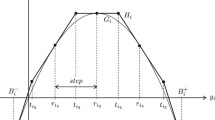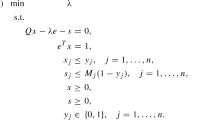Abstract
The global minimization of a large-scale linearly constrained concave quadratic problem is considered. The concave quadratic part of the objective function is given in terms of the nonlinear variablesx ∈R n, while the linear part is in terms ofy ∈R k. For large-scale problems we may havek much larger thann. The original problem is reduced to an equivalent separable problem by solving a multiple-cost-row linear program with 2n cost rows. The solution of one additional linear program gives an incumbent vertex which is a candidate for the global minimum, and also gives a bound on the relative error in the function value of this incumbent. Ana priori bound on this relative error is obtained, which is shown to be ≤ 0.25, in important cases. If the incumbent is not a satisfactory approximation to the global minimum, a guaranteedε-approximate solution is obtained by solving a single liner zero–one mixed integer programming problem. This integer problem is formulated by a simple piecewise-linear underestimation of the separable problem.
Similar content being viewed by others
References
M.S. Bazaraa and H.D. Sherali, “On the use of exact and heuristic cutting plane methods for the quadratic assignment problem“,Journal of Operational Research Society 33 (1982) 991–1003.
H. Crowder, E.L. Johnson and M.W. Padberg, “Solving large-scale zero–one linear programming problems“,Operations Research 31 (1982) 803–834.
J.E. Falk and K.R. Hoffman, “A successive underestimating method for concave minimization problems“,Mathematics of Operations Research 1 (1976) 251–259.
A.M. Frieze, “A bilinear programming formulation of the 3-dimensional assignment problem“,Mathematical Programming 7 (1974) 376–379.
C.D. Heising-Goodman, “A survey of methodology for the global minimization of concave functions subject to convex constraints“,OMEGA, International Journal of Management Science 9 (1981) 313–319.
R. Horst, “An algorithm for nonconvex programming problems“,Mathematical Programming 10 (1976) 312–321.
B. Kalantari, “Large scale concave quadratic minimization and extensions”, Ph.D. thesis, Computer Science Department, University of Minnesota (Minneapolis, MN, 1984).
B. Kalantari and J.B. Rosen, “Construction of large scale global minimum concave quadratic test problems”, to be published inJournal of Optimization Theory and Applications (1986).
H. Konno, “Maximizing a convex quadratic function subject to linear constraints“,Mathematical Programming 11 (1976) 117–127.
E.L. Lawler, “The quadratic assignment problem“,Management Science 9 (1963) 586–599.
O.L. Mangasarian, “Characterization of linear complementarity problems as linear programs“,Mathematical Programming Study 7 (1978) 74–87.
P.M. Pardalos and J.B. Rosen, “Methods for global concave minimization: A bibliographic survey”, to appear inSIAM Review (1986).
M. Raghavachari, “On connections between zero–one integer programming and concave programming under linear constraints“,Operations Research 17 (1969) 680–684.
J.B. Rosen, “Global minimization of a linearly constrained concave function by partition of feasible domain“,Mathematics of Operations Research 8 (1983) 215–230.
J.B. Rosen, “Performance of approximate algorithms for global minimization“,Mathematical Programming Study 22 (1984) 231–236.
J.B. Rosen, “Computational solution of large scale constrained global minimization problems“, in: P.T. Boggs, R.H. Byrd and R.B. Schnabel, eds.,Numerical Optimization 1984 (SIAM, Philadelphia, PA, 1985) pp. 263–271.
L. Schrage,Linear integer and quadratic programming with LINDO (Scientific Press, Palo Alto, CA, 1984).
B.T. Smith, J. Boyle, B. Garbow, Y. Ikebe, V. Klema and C. Moler,Matrix eigensystem routines-EISPACK guide, Lecture notes in computer science, Vol. 6 (Springer-Verlag, New York, 1976).
N.V. Thoai and H. Tuy, “Convergent algorithms for minimizing a concave function“,Mathematics of Operations Research 5 (1980) 556–566.
H. Tuy, “Concave programming under linear constraints“,Doklady Akademii Nauk SSSR 159, 32–35 (English translation inSoviet Mathematics Doklady 5 (1964) 1437–1440).
H. Tuy, “Global minimization of a difference of two convex functions“, in:Selected topics in operations research and mathematical economics. Lecture Notes in Economics and Mathematical Systems 226 (1984) 98–118.
H. Watanabe, “IC layout generation and compaction using mathematical optimization”, Ph.D. Thesis, Computer Science Department, University of Rochester (Rochester, NY, 1984).
N. Zilverberg, “Global minimization for large scale linearly constrained systems”, Ph.D. Thesis, Computer Science Department, University of Minnesota (Minneapolis, MN, 1983).
Author information
Authors and Affiliations
Additional information
Dedicated to Professor George Dantzig in honor of his 70th Birthday.
This research was supported by the Division of Computer Research, National Science Foundation under Research Grant DCR8405489.
Rights and permissions
About this article
Cite this article
Rosen, J.B., Pardalos, P.M. Global minimization of large-scale constrained concave quadratic problems by separable programming. Mathematical Programming 34, 163–174 (1986). https://doi.org/10.1007/BF01580581
Received:
Revised:
Issue Date:
DOI: https://doi.org/10.1007/BF01580581




